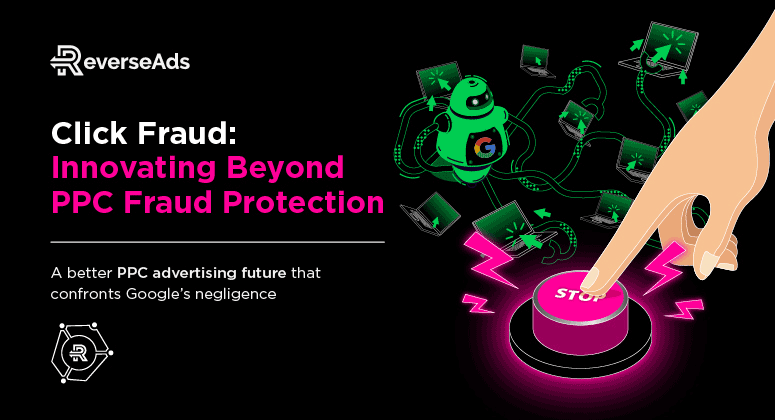Click Fraud: Innovating Beyond PPC Fraud Protection

A Better PPC Advertising Future That Confronts Google’s Negligence
Did you know that one in five clicks on pay-per-click (PPC) advertising are invalid? PPC fraud is costing more than $30 billion a year in advertising loss. This number is set to skyrocket as we head into an increasingly competitive (and saturated) online advertising market. It’s an intimidating fact that confronts every marketer looking to optimize their paid ad campaigns, particularly on the likes of Google and Facebook.
Hot On The Trail of Click Fraud
Let’s begin by breaking down the definition of click fraud. It’s a widely used term in pay-per-click online advertising when a person, automated script, or computer program imitates a legitimate user of a web browser clicking on an ad to generate a charge per click—without having any genuine interest in the actual ad.
It’s not all just from bots and click farms either, but a wide range of reasons like users who click on the first result they see. The underlying issue of click fraud is invalid traffic which encompasses any advertising engagement that isn’t out of genuine interest in the advertised products or services. Invalid traffic can be malicious (ad fraud), non-malicious or accidental and are notoriously challenging (read: labor-intensive) to stop.
As soon as you’ve put a stop to one, another ten appear; it’s tough to kill, like a ‘90s trend.
Therefore, the best way to protect your business is to ensure preventive measures are in place to watch your back and diversify your online advertising strategies beyond Google and Facebook. Fortunately, ReverseAds’ “Pay-Per-Considered-Visitor” model provides marketers with just the alternative (keep reading as we get to this).
No one is immune from invalid traffic, whether you’re a business with a $100 or a $100k monthly budget. The most significant cost of invalid traffic is the lost opportunity associated with wasted ad spend; an estimated 10-30% of PPC budgets are wasted on ad fraud. With 11% of search ad clicks and 36% of display ad clicks being invalid, and the online advertising world booming due to the pandemic, it’s more important than ever that marketers treat click fraud as a serious threat to their business rather than a myth.
All Roads Do Not Lead to Rome
The Global Click Fraud Report by PPC Protect in January 2021 found that closely behind the death of 3rd party cookies as well as maintaining General Data Protection Regulation (GDPR) and privacy compliance, 31.8% of marketers are concerned about click fraud.

The tedious nature of the task, like a game of cat and mouse, is a marketer’s living nightmare.
There are also significant concerns about the lack of transparency, accountability and reliability of many ad fraud protection platforms. Many guarantee 100% protection but aren’t adapting fast enough, remain overly reliant on outdated technology and selling purely on fear-based marketing, rather than innovating and truly trying to prevent fraud.
Not only are these outdated protection methods not effective enough, they’re often providing wrong and, in some cases, downright harmful information to advertisers, which leads to significant damage to their PPC campaigns and conversion activity. Furthermore, if you’re trusting someone to block click fraud for you, you need to know that the data they are reporting is accurate, and they’re not just inflating figures to grab a sale.
Banging Your Head Against The Walls of Google’s Reactive Approach
A common argument heard is that Google takes care of invalid traffic protection. As it continues to monopolize the world of digital ads, you would assume that Google has the wherewithal and incentive to protect its customers. However, its one-size-fits-all solution—Google’s Ad Traffic Quality team who manually analyzes and reviews invalid clicks, a small team of just 100 from over a hundred thousand of its employees—fails to live up to the modern-day advertiser’s expectations.
Some of the conventional methods used to combat click fraud are no click counts on ads from visitors with VPN, proxy, very outdated web browsers, competitor IPs, macros and browser add-ons and refunds on invalid clicks. Google promises a refund once every 60 days but you would have to sift through your data and find exactly what they need. Now we’re back to a marketer’s nightmare of tedious labor-intensive legwork. What’s worse is that it takes you away from other value-generating tasks that you would much rather be doing; for instance, serving ads to real authentic customers!
Google’s systems don’t actually block invalid traffic – which means that botnet rings, click farms, competitors and others simply retarget you. Invalid clicks will still enter your campaign metrics and mess up your data; without clean data, marketers are powerless when it comes to effective campaign optimization decisions.
There have been many cases splashed across the headlines that shine a spotlight on Google’s lack of transparency, where Google failed to lift the lid on their invalid traffic practices to provide further insights into fraud data. It’s easy to sit back and believe Google has got this; to think that if your campaigns are turning a profit then you can’t be being targeted, and even if you are, it’s barely noticeable. This is simply not true. Google is normalizing ad fraud and marketers are playing catch up in a losing battle to anticipate what might change next.
Google’s priorities will always remain with what turns a profit – clicks.
It’s time for marketers to be proactive rather than reactive in safeguarding ad campaigns against click fraud, and to not rely on Google’s (lack of) moral obligation toward its customers.
On The Warpath for a Better Advertising Pricing Model Against PPC Fraud
Finally, let’s talk about an alternative future – the extinction of click fraud. Every dollar that you don’t spend on ad fraud helps you reach more potential customers. By stopping ad fraud, you can increase your advertising reach to get more genuine ad engagement and better PPC advertising performance.
By fusing blockchain technology with ReverseAds’ “Pay Per Considered Visitor” model, advertisers are only charged for true considered clicks when a user spends longer than 20 seconds on your website, visits three pages or reaches 100% scroll depth. We are so confident in our keyword algorithm that we are able to offer clear definitions and requirements of invalid clicks to guarantee that your ad budget will only be spent on true considered visitors.
Here’s where you might be asking yourself: what’s the catch? Leave the walled gardens of Google and Facebook, and serve your ads on the open web (66% of your customers’ screen time are spent here) where our blockchain solution provides transparency in ad campaigns by validating and consistently tracking all metrics from views and engagement rates to precision of targeting.
In a nutshell, not only does this revolutionary approach actively unravels Google’s ad monopoly but it also eliminates overspending on ad campaigns with exponential reach and improved targeting to connect brands with high-intent customers. This ultimately creates genuine ad engagement and sustainable relationships with your customers.
So, it’s not all bad news. At least not when marketers choose to take a proactive rather than reactive approach against click fraud.





